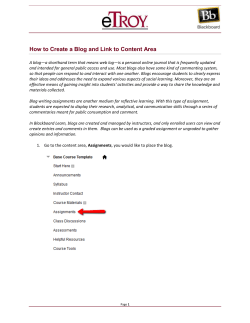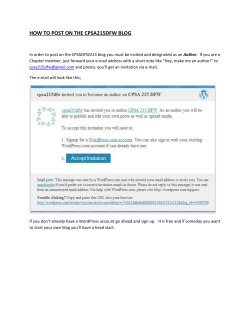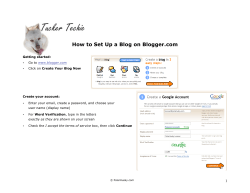
Blogger Relations Guide: How to Build an Army of Supporters
Blogger Relations Guide: How to Build an Army of Supporters Getting Started You’ve worked hard to build a solid network of traditional media contacts for your program outreach and campaigns. But, have you tapped into bloggers, too? Chances are if you haven’t, you’re missing out on some excellent opportunities for coverage. A survey from TheFutureBuzz Blog in January of 2009 showed blogs are extremely prevalent within the World Wide Web. Statistics revealed over 133 million blogs had been indexed at the date the report was released and that 346 million people around the world read blogs regularly. To optimize your opportunities with bloggers who may be interested in supporting your programs and campaigns, you’ll need to know how to best relate to bloggers. Here are some important tips for communications professionals to keep in mind when working with bloggers: • Understand that blogs are social communities just like Facebook, LinkedIn and Twitter. Even with the rise of social media, blogs as communities are expected to continue to increase in popularity in 2010. They’re extremely popular mediums for influential experts to share their opinions, experiences and information real time. Building trusted relationships with highauthority bloggers can help expose your message to the audience you’re trying to reach and as a result, grow your constituency base. • Find the right bloggers to approach. Just like with mainstream media, when you’re building a list of blogger contacts to pitch about a program or campaign, put some thought, time and resources into building the most targeted list. Use Technorati to search for blogs with high authority numbers that contain your associated keywords. Another popular blog database in Google Blogs. Lastly, you can use Twitterati to find top bloggers who also have a micro-blog account on Twitter. • Plan an outreach timeline. One of the most important things to remember is that successful coverage from bloggers is typically achieved by developing long-term relationships. You’ll want to begin building the relationship long before you need them for a particular campaign. Consider creating an outreach timeline such as this one: • • • Two months before a campaign: Conduct blogger research and finalize a blogger target list One month before a campaign: Introduce yourself to target bloggers and begin communicating with them. One week before a campaign: Send your bloggers a personalized, casual “heads up” note about your campaign. Ask the bloggers if they would like to participate first similar to an optin choice. • Earn trust with bloggers. Read a blogger’s bio and their recent blog posts. Research bloggers’ opinions on the subject of your program or campaign. Find bloggers in other social networks they belong to and follow their updates. After you’ve done your research, communicate with each blogger on a regular basis by leaving comments that add value to their posts. If you have their contact information, consider sending personalized emails or direct Twitter tweets. • Write your blog pitch. When you’re ready to write your pitch about your campaign, pay the most attention to your headline. It should be unique, attention grabbing and communicate a sense of urgency for the blogger to act. Use bullets for key messages or calls to action. Keep it brief. • Make your pitch relevant. Reference details that shows you read the blogger’s blog. Make sure you appeal to the blogger’s emotions and clearly communicate why they should care about your campaign. Add plenty of digital resources such as trackable links and photos a blogger could use to enhance his or her story. • Exercise stellar follow up and graciousness for coverage received. If you don’t get a response from a blogger right away, don’t be discouraged. Bloggers are busy and for most it’s a second job or a hobby. Be respectful by giving the blogger time to respond. If you don’t hear back, follow up with a note. When you do get coverage, thank bloggers individually and let them know that you’ve promoted their coverage, which in turn drives additional traffic back to their blog. • Track your blog coverage. Free tracking tools we recommend include: Google Alerts, Technorati and for Twitter, TweetBeep. If you’re interested in paid tools, which offer much more detailed insight and automation, Mashable blog reviewed the top ten on the market in this article. • Learn what’s to come. Predictions for blogging in 2010 include an increase in mobile blogging, weaving more video capabilities into blogs, the practice of incorporating more real-time trends into blog posts, blogging more frequently (on one’s own blog and on others’ blogs via guest posts) and the further increase in popularity of micro-blogs, like Twitter. For More Information These websites are excellent resources for finding news and/or blog content in relation to blogs: Google Alerts (http://www.google.com/alerts) Alerts for content within the WWW and Blogosphere that contain keywords you specify Google Blog Search (http://blogsearch.google.com/) A popular search engine from Google that indexes blogs by keyword “tags” Technorati (Http://www.technorati.com) A popular search engine that indexes blogs by authority level and keyword “tags” TweetBeep (http://tweetbeep.com/) Alerts for tweets within Twitter that contain keywords you specify Twitterati (http://twittorati.com/) A tracking database of Twitter accounts and tweets from the top 100 highest authority blogger Resource Media | 325 Pacific Avenue San Francisco CA 94111 | 415.397.5000 | www.resource-media.org
© Copyright 2025


















